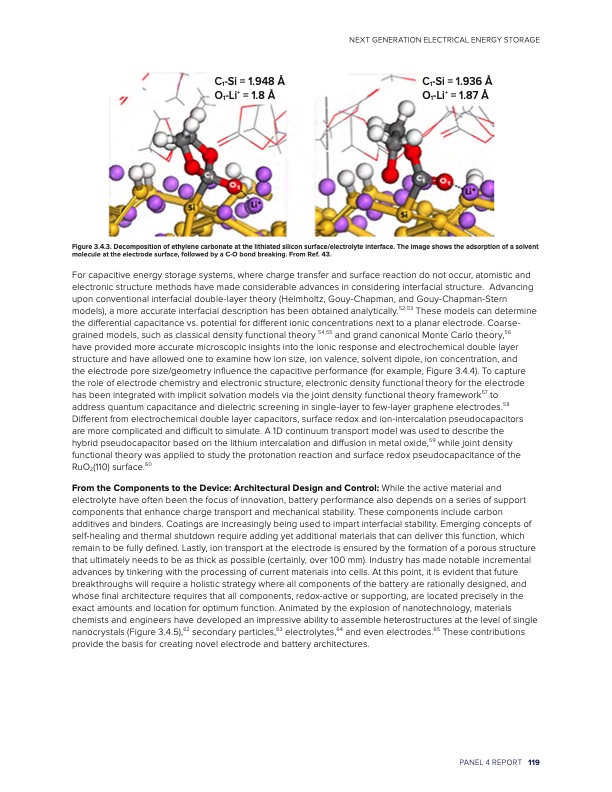
PDF Publication Title:
Text from PDF Page: 125
C1-Si = 1.948 Å C1-Si = 1.936 Å O1-Li+ = 1.8 Å O1-Li+ = 1.87 Å Figure 3.4.3. Decomposition of ethylene carbonate at the lithiated silicon surface/electrolyte interface. The image shows the adsorption of a solvent molecule at the electrode surface, followed by a C-O bond breaking. From Ref. 43. For capacitive energy storage systems, where charge transfer and surface reaction do not occur, atomistic and electronic structure methods have made considerable advances in considering interfacial structure. Advancing upon conventional interfacial double-layer theory (Helmholtz, Gouy-Chapman, and Gouy-Chapman-Stern models), a more accurate interfacial description has been obtained analytically.52,53 These models can determine the differential capacitance vs. potential for different ionic concentrations next to a planar electrode. Coarse- grained models, such as classical density functional theory 54,55 and grand canonical Monte Carlo theory,56 have provided more accurate microscopic insights into the ionic response and electrochemical double layer structure and have allowed one to examine how ion size, ion valence, solvent dipole, ion concentration, and the electrode pore size/geometry influence the capacitive performance (for example, Figure 3.4.4). To capture the role of electrode chemistry and electronic structure, electronic density functional theory for the electrode has been integrated with implicit solvation models via the joint density functional theory framework57 to address quantum capacitance and dielectric screening in single-layer to few-layer graphene electrodes.58 Different from electrochemical double layer capacitors, surface redox and ion-intercalation pseudocapacitors are more complicated and difficult to simulate. A 1D continuum transport model was used to describe the hybrid pseudocapacitor based on the lithium intercalation and diffusion in metal oxide,59 while joint density functional theory was applied to study the protonation reaction and surface redox pseudocapacitance of the RuO2(110) surface.60 From the Components to the Device: Architectural Design and Control: While the active material and electrolyte have often been the focus of innovation, battery performance also depends on a series of support components that enhance charge transport and mechanical stability. These components include carbon additives and binders. Coatings are increasingly being used to impart interfacial stability. Emerging concepts of self-healing and thermal shutdown require adding yet additional materials that can deliver this function, which remain to be fully defined. Lastly, ion transport at the electrode is ensured by the formation of a porous structure that ultimately needs to be as thick as possible (certainly, over 100 mm). Industry has made notable incremental advances by tinkering with the processing of current materials into cells. At this point, it is evident that future breakthroughs will require a holistic strategy where all components of the battery are rationally designed, and whose final architecture requires that all components, redox-active or supporting, are located precisely in the exact amounts and location for optimum function. Animated by the explosion of nanotechnology, materials chemists and engineers have developed an impressive ability to assemble heterostructures at the level of single nanocrystals (Figure 3.4.5),62 secondary particles,63 electrolytes,64 and even electrodes.65 These contributions provide the basis for creating novel electrode and battery architectures. NEXT GENERATION ELECTRICAL ENERGY STORAGE PANEL 4 REPORT 119PDF Image | Next Generation Electrical Energy Storage

PDF Search Title:
Next Generation Electrical Energy StorageOriginal File Name Searched:
BRN-NGEES_rpt-low-res.pdfDIY PDF Search: Google It | Yahoo | Bing
Sulfur Deposition on Carbon Nanofibers using Supercritical CO2 Sulfur Deposition on Carbon Nanofibers using Supercritical CO2. Gamma sulfur also known as mother of pearl sulfur and nacreous sulfur... More Info
CO2 Organic Rankine Cycle Experimenter Platform The supercritical CO2 phase change system is both a heat pump and organic rankine cycle which can be used for those purposes and as a supercritical extractor for advanced subcritical and supercritical extraction technology. Uses include producing nanoparticles, precious metal CO2 extraction, lithium battery recycling, and other applications... More Info
| CONTACT TEL: 608-238-6001 Email: greg@infinityturbine.com | RSS | AMP |